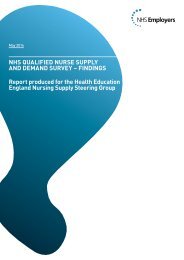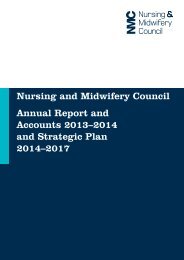Journal_1_2014_final_WEB
Journal_1_2014_final_WEB
Journal_1_2014_final_WEB
Create successful ePaper yourself
Turn your PDF publications into a flip-book with our unique Google optimized e-Paper software.
Scientific Communication<br />
strategies and novel models of wound infection involving<br />
disruption of the biofilm alone or in combination with<br />
antimicrobial agents.<br />
Disruption of biofilms has been demonstrated with<br />
ultrasound waves. Although the endpoint of most studies<br />
has been surface release from young biofilms (i.e., not<br />
necessarily equal to a reduced infection); some studies have<br />
managed to prove that ultrasound waves can effectively enhance<br />
the efficacy of antimicrobials (45-50 . Clinical studies<br />
of ultrasound wound debridement have also shown good<br />
effects 51,52 ; however, the decrease in bacterial counts were<br />
not significant 51 . This non-significant decrease in bacterial<br />
burden could be explained by the difficulties in detecting<br />
biofilms, but it has also been suggested that the positive<br />
effect arises from a multitude of factors such as cellular<br />
recruitment and stimulation, collagen synthesis, angiogenesis,<br />
and fibrinolysis (53,54 . However, non-published data<br />
from our laboratory and the recent knowledge of biofilms<br />
in non-healing wounds has led to the hypothesis that ultrasound,<br />
in addition to the above mentioned parameters,<br />
aids biofilm disruption and thereby wound healing 55 .<br />
Maggot debridement therapy of non-healing wounds<br />
was approved in 2004 by the FDA and has been shown to<br />
possess an antibacterial effect in combination with other<br />
wound healing properties 56-59 . An interesting study has<br />
recently shown that larvae actually combine physical<br />
disruption with enzymatic destabilization of wound biofilms<br />
60 . As mentioned in the introduction, DNA stabilizes<br />
all biofilms. Apparently, in addition to physically grazing,<br />
the biofilm larvae secrete DNases that degrade DNA and<br />
thereby further weaken the biofilm structure. As with the<br />
ultrasound, larvae also have secondary positive effects on<br />
wound healing immunomodulation, angiogenesis, and<br />
tissue remodelling and regeneration, and this may explain<br />
their beneficial effects on wound healing. Another<br />
example of combining disruption of biofilms with positive<br />
secondary effects is negative pressure therapy 61-63 . The<br />
authors found that negative pressure disrupted the matrix<br />
of biofilms on porcine skin implants, making them more<br />
susceptible to antiseptics 61 .<br />
As observed with other biofilm infections, targeting<br />
several factors in wound biofilms seems to be a solid strategy<br />
worth investigating. In the case of wound healing, the<br />
secondary effects as discussed above might even be more<br />
pronounced and thus constitute a promising strategy.<br />
The tasks<br />
From the above discussion of the impact of biofilms, it is<br />
clear that we have a number of tasks to solve. First of all,<br />
in order to prove that biofilm plays the role it is believed<br />
to do, we need to improve diagnostic methods. This task<br />
is also paramount when evaluating anti-biofilm strategies<br />
in vivo. Secondly, the study of possible treatment strategies<br />
for biofilm infections needs to be expanded and the<br />
in vitro models need to be aligned to simulate the wound<br />
in the best possible way.<br />
For these tasks to be solved, it is important that scientists,<br />
doctors, and wound healing specialists communicate<br />
and share their thoughts and concerns on the issue. If<br />
we combine the knowledge of wound care professionals<br />
and basic scientists, we can hopefully take a giant leap<br />
towards turning non-healing wounds into healing wounds.<br />
Such multidisciplinary communication between doctors<br />
and biofilm researchers has contributed significantly to<br />
the treatment of chronic lung infections in patients with<br />
the genetic disorder cystic fibrosis 64,65 . Communication<br />
through research journals is significant; however, it is our<br />
experience that the most fruitful results and collaborations<br />
come from live discussions and consensus debates at conferences.<br />
At the EWMA conference in 2013, the topic of<br />
biofilms was for the first time denoted in an EWMA document;<br />
furthermore, a number of abstracts dealt with biofilms<br />
in addition to the popular workshop. In particular,<br />
at the workshop, we had a great discussion on the future<br />
of biofilm research. It is our hope that even more people,<br />
from all branches of wound care, will attend the biofilm<br />
workshops at EWMA GNEAUPP <strong>2014</strong> in Madrid, so<br />
we can discuss the best approach to finding better ways<br />
to study, diagnose, and treat biofilm-infected wounds.m<br />
References<br />
1. Costerton, J. W., P. S. Stewart, and E. P. Greenberg.<br />
1999. Bacterial biofilms: a common cause of<br />
persistent infections. Science 284:1318-1322.<br />
2. Costerton, J. W., K. J. Cheng, G. G. Geesey, T. I.<br />
Ladd, J. C. Nickel, M. Dasgupta, and T. J. Marrie.<br />
1987. Bacterial biofilms in nature and disease.<br />
ANNU REV MICROBIOL 41:435-464.<br />
3. Davey, M. E., and A. O’Toole G. 2000. Microbial<br />
biofilms: from ecology to molecular genetics.<br />
Microbiol Mol Biol Rev 64:847-867.<br />
4. Costerton, J. W., G. G. Geesey, and K. J. Cheng.<br />
1978. How bacteria stick. Sci Am 238:86-95.<br />
5. Costerton, W., R. Veeh, M. Shirtliff, M. Pasmore, C.<br />
Post, and G. Ehrlich. 2003. The application of<br />
biofilm science to the study and control of chronic<br />
bacterial infections. J Clin Invest 112:1466-1477.<br />
6. Bjarnsholt, T., P. Ø. Jensen, M. J. Fiandaca,<br />
J. Pedersen, C. R. Hansen, C. B. Andersen, T.<br />
Pressler, M. Givskov, and N. Høiby. 2009. Pseudomonas<br />
aeruginosa biofilms in the respiratory tract<br />
of cystic fibrosis patients. Pediatr Pulmonol 44:547-<br />
558.<br />
7. Høiby, N., T. Bjarnsholt, M. Givskov, S. Molin, and<br />
O. Ciofu. 2010. Antibiotic resistance of bacterial<br />
biofilms. Int J Antimicrob Agents 35:322-332.<br />
8. Kirketerp-Møller, K., P. Ø. Jensen, M. Fazli, K. G.<br />
Madsen, J. Pedersen, C. Moser, T. Tolker-Nielsen,<br />
N. Høiby, M. Givskov, and T. Bjarnsholt. 2008.<br />
Distribution, organization, and ecology of bacteria in<br />
chronic wounds. J Clin Microbiol 46:2717-2722.<br />
9. Fazli, M., T. Bjarnsholt, K. Kirketerp-Moller, B.<br />
Jorgensen, A. S. Andersen, K. A. Krogfelt, M.<br />
Givskov, and T. Tolker-Nielsen. 2009. Nonrandom<br />
distribution of Pseudomonas aeruginosa and<br />
Staphylococcus aureus in chronic wounds. J Clin<br />
Microbiol 47:4084-4089.<br />
10. Bjarnsholt, T., T. Tolker-Nielsen, M. Givskov, M.<br />
Janssen, and L. H. Christensen. 2009. Detection of<br />
bacteria by fluorescence in situ hybridization in<br />
culture-negative soft tissue filler lesions. Dermatol<br />
Surg 35 Suppl 2:1620-1624.<br />
11. Høiby, N., O. Ciofu, and T. Bjarnsholt. 2010.<br />
Pseudomonas aeruginosa biofilms in cystic fibrosis.<br />
Future microbiology 5:1663-1674.<br />
12. Nickel, J. C., I. Ruseska, J. B. Wright, and J. W.<br />
Costerton. 1985. Tobramycin resistance of<br />
Pseudomonas aeruginosa cells growing as a biofilm<br />
on urinary catheter material. Antimicrob Agents<br />
Chemother 27:619-624.<br />
13. Whitchurch, C. B., T. Tolker-Nielsen, P. C. Ragas,<br />
and J. S. Mattick. 2002. Extracellular DNA required<br />
for bacterial biofilm formation. Science 295:1487.<br />
<br />
EWMA <strong>Journal</strong> <strong>2014</strong> vol 14 no 1 57




